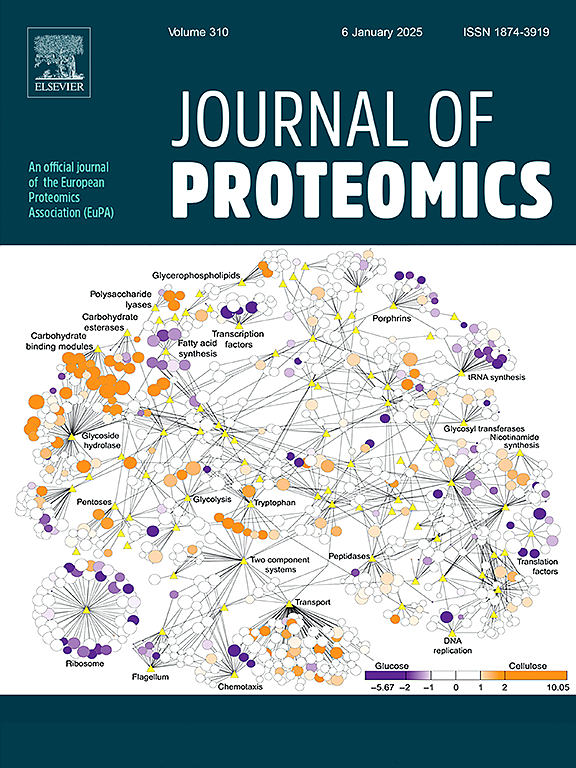E钙粘蛋白似乎是启动胆管形成的重要开关。
IF 2.8
2区 生物学
Q2 BIOCHEMICAL RESEARCH METHODS
引用次数: 0
摘要
细胞极化的机制是生物学的基础,但仍未完全理解。对于肝细胞来说尤其如此,肝细胞表现出特别复杂的极化,使胆小管(BC)网络的形成对肝脏排泄功能至关重要。为了确定参与肝细胞极化、BC形成、结构或功能的关键蛋白,我们采用了蛋白质组学方法,将人肝细胞系HepG2与其亚克隆HepG2/C3A进行比较,后者在形成成熟BC方面的效率明显更高。通过这一分析,我们首次将LimA1和Espin定位到BC,提示它们在该室中的重要作用,并证实了NHE-RF1的存在。使用靶向蛋白抑制策略,我们发现E钙粘蛋白是启动BC形成所必需的,不像其他粘附连接成分,如N钙粘蛋白或α-catenin。我们的研究结果首次证明,在缺乏E钙粘蛋白的情况下,肝细胞失去了形成bc的能力。意义:本研究旨在加深我们对肝细胞高度特化极化与胆管形成的关系的理解。主要发现是e -钙粘蛋白在这一过程中的关键作用,在2D和3D培养模型中,它似乎对胆小管的形成至关重要。此外,该研究还鉴定了几种可能定位于胆管的蛋白质,其功能仍有待阐明。本文章由计算机程序翻译,如有差异,请以英文原文为准。

E cadherin appears to be an essential on/off switch for initiating bile canaliculi formation
The mechanisms underlying cell polarization are fundamental to biology but remain incompletely understood. This is especially true for hepatocytes, which display a particularly complex polarization that enables the formation of the bile canaliculi (BC) network crucial for liver excretory functions. To identify key proteins involved in hepatocyte polarization, BC formation, structure or function, we employed a proteomic approach comparing the human hepatocyte cell line HepG2 to its sub clone HepG2/C3A known for its markedly greater efficiency in forming mature BCs. Through this analysis, we localized LimA1 and Espin to the BC for the first time, suggesting their important role in this compartment, and confirmed the presence of NHE-RF1. Using a targeted protein repression strategy, we identified E cadherin as essential for the initiation of BC formation, unlike other adherens junction components such as N cadherin or α-catenin. Our findings demonstrate, for the first time, that in the absence of E cadherin, hepatocytes lose the capacity to form BCs.
Significance
This study aims to deepen our understanding of the highly specialized polarization of hepatocytes in relation to bile canaliculus formation. The major finding is the key role of E cadherin in this process, where it appears to be essential for bile canaliculus formation in both 2D and 3D culture models. Additionally, the study led to the identification of several proteins potentially localized to the bile canaliculi, whose functions remain to be elucidated.
求助全文
通过发布文献求助,成功后即可免费获取论文全文。
去求助
来源期刊

Journal of proteomics
生物-生化研究方法
CiteScore
7.10
自引率
3.00%
发文量
227
审稿时长
73 days
期刊介绍:
Journal of Proteomics is aimed at protein scientists and analytical chemists in the field of proteomics, biomarker discovery, protein analytics, plant proteomics, microbial and animal proteomics, human studies, tissue imaging by mass spectrometry, non-conventional and non-model organism proteomics, and protein bioinformatics. The journal welcomes papers in new and upcoming areas such as metabolomics, genomics, systems biology, toxicogenomics, pharmacoproteomics.
Journal of Proteomics unifies both fundamental scientists and clinicians, and includes translational research. Suggestions for reviews, webinars and thematic issues are welcome.
 求助内容:
求助内容: 应助结果提醒方式:
应助结果提醒方式:


